Diggin' In
The Richard Gienger Report
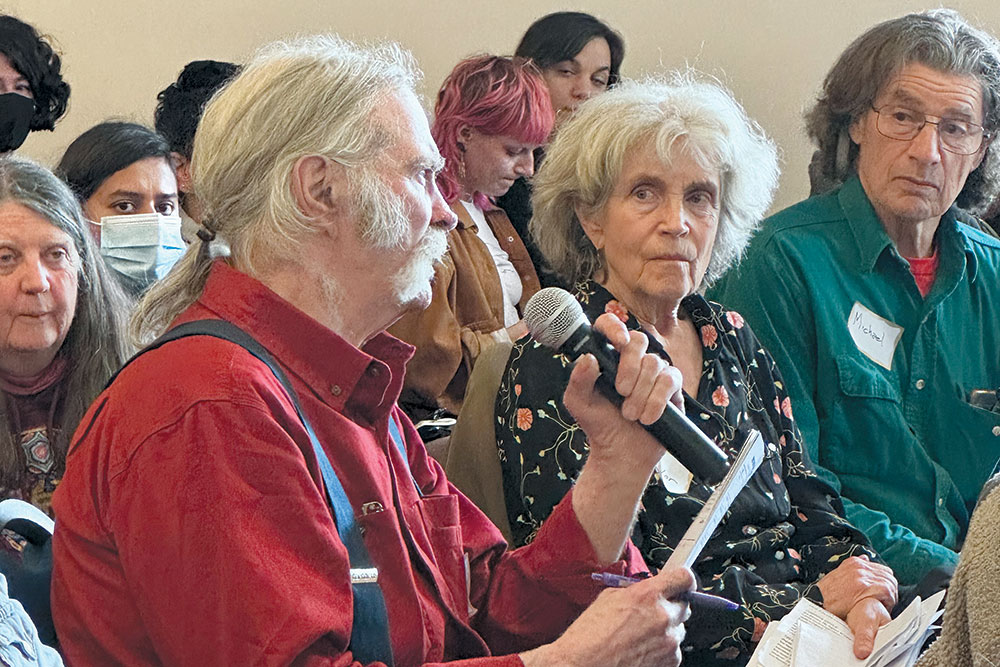
Nancy Peregrine and the Fight for Sally Bell Grove Remembered, Paying Attention to Local Forestry, Enacting Good Stewardship, Book Nook
Once again, some things to share: Part of my last column was dedicated to Nancy Peregrine, Fred “Coyote” Downey, and Lon Mulvaney, all lost by the community recently. This column is being drafted just before a celebration of Nancy’s life at the Mateel Community Center on March 18th. Nancy positively influenced hundreds of persons and perspectives during her lifetime. I am going to focus on two high impacts she had: protection of the Sally Bell Grove and the Sinkyone Wilderness Coast, and the struggle to save Vista Ridge, a spectacular old-growth Douglas-fir grove along the headwaters of the Mattole River.
Nancy Was There
Nancy was essential connective consciousness for what she sometimes referred to as the “unintentional” community of Whale Gulch and neighboring villages. Starting in the 1970s there was strong sentiment across many communities to protect any old growth and remnant forests, especially among “reinhabitors/hippies” witnessing the impacts of “total logging” and massive floods. Locally this focus was especially strong in resisting the depredations of Georgia-Pacific (G-P), starting in 1975, in its relentless drive to take all remaining merchantable timber, particularly old-growth redwood between Usal and Bear Harbor. People appealed to every possible ally and process to stop the destruction—exhausting administrative and legislative remedies (due diligence, due diligence, due diligence; Timber Harvest Plan by THP, and trying to stop the destruction of one after another archaeological/cultural sites).
In September 1977, G-P filed a plan to take all timber out of Little Jackass Creek canyon. (Lots of details for another time: Cal Parks and Rec combining the Bear Harbor and Usal projects—also in September 1977 in Fort Bragg—that would become the current Sinkyone State Wilderness, InterTribal Sinkyone Wilderness, and Sinkyone Wilderness State Park. The California Department of Forestry backed G-P down to do the cutting in stages.
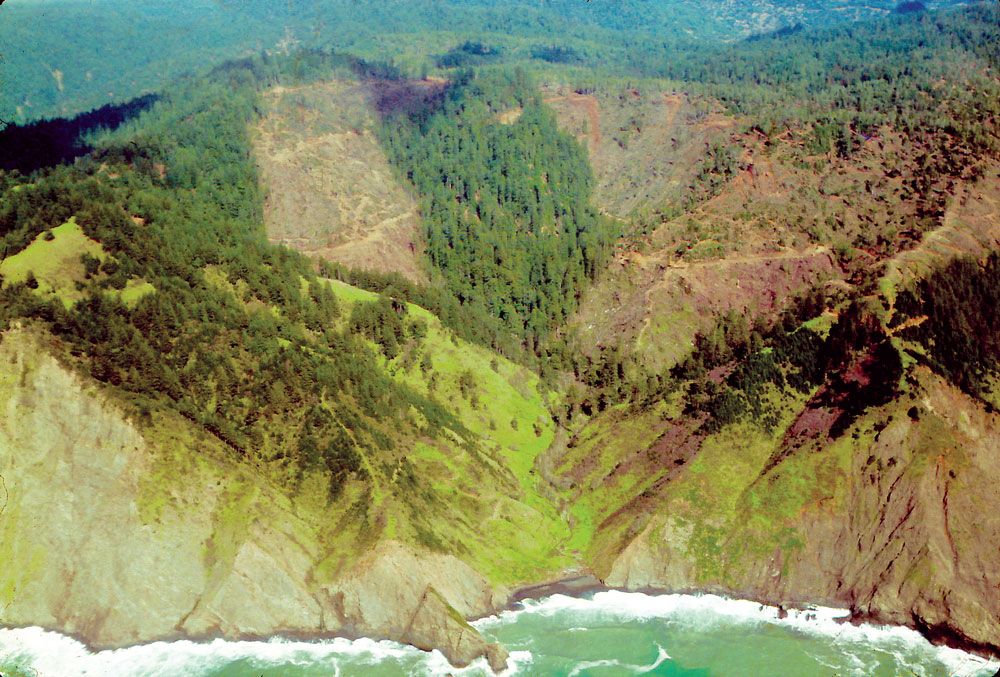
Photo by Richard Gienger
After continued protracted struggle came the proverbial last straw: G-P came back in 1983 for the remaining old growth in the Little Jackass Creek watershed, which almost immediately became known as the Sally Bell Grove watershed, because that keystone ridge preserved the old-growth presence behind and above the beautiful cove at the base of the canyon and the ancient and precious cultural heritage. Sally Bell was a renowned survivor of a massacre of Native people in the Needle Rock area that took most of her family. The clearcut THP triggered the start of litigation in a Mendocino County court—what became the precedent-setting EPIC v. Johnson Appeal Court decision in 1985 (Environmental Protection Information Center and the International Indian Treaty Council v. California Department of Forestry and G-P).
Cutting to the dire situation: G-P moving in to cut as soon as the THP was approved and no restraining order or stay in place. Concerned surrounding communities had come together close to Nancy’s home. Mike Roselle, fresh from civil defense of the Kalmiopsis Wilderness in Oregon, came to help get affinity groups together. He and other veterans of the struggles against herbicides and nuclear power plants get deep into non-violent resistance. And the morning of the day came: “They are cutting, they are cutting!” Several waves of civil defense ensued. Some trees had been cut, then operations were stopped on the first day the civil defenders showed up. But in the time between the adverse ruling of the local court and action by the appeals court, the situation on the ground got out of hand. G-P fallers were trying to cut as much and as fast as they could. Mem Hill was caught under a Tan Oak tree toppled by an old-growth redwood. Seven women were arrested and taken to jail in Ukiah. And then the Appeals Court Stay of Operation came through, but it took a while for the sheriffs to ensure enforcement throughout the Grove. Anxiety, anxiety…how are the women doing? No worry, the contagious and joyful laughter of Nancy Peregrine spread through the jail, a true expression of inspiring indomitable spirit.
Nancy displayed the same fortitude and responsibility in defense of the old-growth Douglas-fir grove on Vista Ridge, watching out for forest defenders and keeping close constant radio contact to relay a court-ordered stop of operations as soon as it happened. And she did. Law enforcement typically took some time to get its own verification. Unfortunately the grove was later cut, but through multiple efforts of Sanctuary Forest and funding from the State of California and support from others, Vista Ridge is permanently protected as a key part of the extensive area conserved in the salmonid refugia and precious old-growth groves and stands of the Mattole River Headwaters. Nancy was there allatime.
Quite a Winter
It’s been quite a winter and almost to spring: big rains labeled atmospheric rivers, earthquakes, and snow from late December 2022 through March 2023. Rio Dell and Fernbridge experienced major shakeup and damage, roads failing (dropping out, buried, or blocked), power lines down, thousands of trees down, deep snow and drifts. People were trapped in or close to home for days or even weeks. Whale Gulch was hit especially heavy on the coast with unusual amounts of snow coupled with winds and water-saturated soils.
And how about Highway 101 with two lanes gone from the two-lane overlook of the historic Reggae on the River site? The landslide has been and will continue to be active on an outside bend of the South Fork Eel River. And, ahem, this brings up CalTrans still trying to shove through the Richardson Grove boondoggle in this same area. This will be EPIC’s fourth “head them off at the pass” moment—and the Humboldt County Supervisors may be joining the opposition. From the beginning the CalTrans Richardson Grove project made no sense, even beyond the unacceptable impact on the Grove. The Richardson Grove section itself is stable, but the ground above outside bends of the South Fork on either side of the Grove IS NOT. On the south side, Highway 101 was basically erased by this year’s winter storms, and on the north side freshly applied asphalt is covering up subsidence and “scarpage” that have been underway almost every year, and in geological time. Better save your millions (billions), CalTrans and California, for real highway problems. Lay off the needless cosmetic and adverse-impact-prone fake problems.
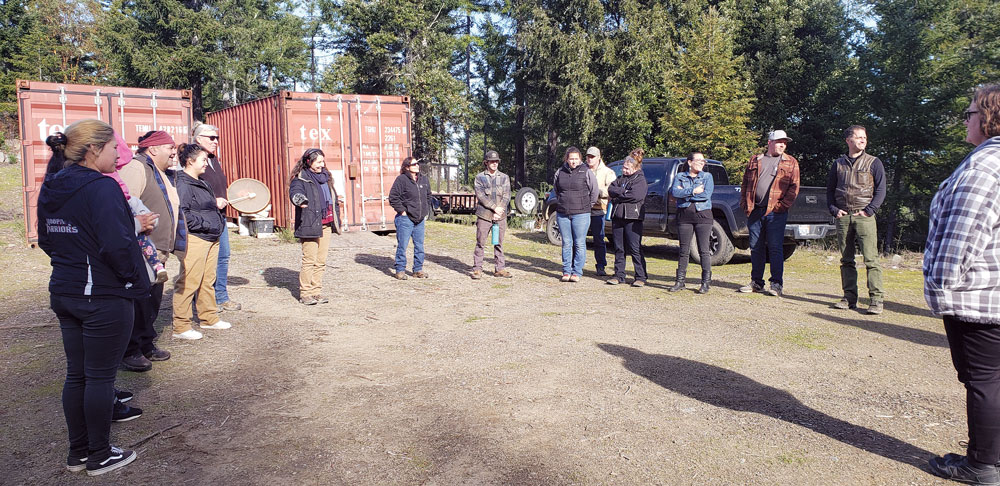
Please Pay Attention!
And the rants keep coming: Please pay attention to the ongoing and multifaceted PG&E industrial powergrid nightmare. PG&E information and action link: http://endpowerlinefires.com
Please pay attention to the need for real forest and water stewardship, including dam removal, co-management, and landback. Got to turn it around, bit by bit, step by step, model by model.
Save California Salmon is a highly recommended non-profit giving solidly sane takes on issues, events, and action as if people and the Earth matter.
Please pay attention to turning around the industrial plantation-based economies that so much of the world is trapped in. At least make headway on alternative models whenever you can and wherever you are.

Right now the future of the stewardship of California forests, for the forested watersheds and the people who depend on them, is swaying in the balance of making a viable model for the future in Jackson Demonstration State Forest. This is a last chance to model a watershed recovery that can work and be broadly applied. The vision and decisions about this “modernization” must transcend political sleight of hand and the continued cadre of control by the CAL FIRE/Board of Forestry/Forest Industrial complex.
Talkin’ about that Board of Forestry, back then and again now…
Been trying to sketch out information pertaining to all of this in the 72 “Diggin’ In” columns so far written for Forest and River News. Before I turn to some examples of good news, I want to share some earnest, thoughtful, real, and gentle but firmly expressed critiques of the Board of Forestry and CAL FIRE by Kim Rodrigues, RPF, former Board of Forestry and Professional Forester Examining Committee member. She has had an outstanding career with UC Cooperative Extension—Agriculture and Natural Resources. This was written in May 2016 when Kim concluded that she was unable to commit to the degree of engagement that she felt was necessary to continue as a Board member. You may notice her emphasis on AB 1492 and Pilot Project Watersheds. These two basic actions are supposed to be a foundation for forest and watershed recovery with full public participation and transparency, but they were “kicked to the curb” after that intent and implementation was subverted and ignored.
Excerpts from Kim Rodrigues 2016 Letter
“The BOF is addressing critical, long-term issues that will influence our future forest structure and function for decades to come, particularly during this period of intense management pressures due to drought-related mortality and climate change. This is a huge responsibility and requires fully committed BOF members.”
“. . . support future efforts to more fully engage the public and all interested stakeholders in AB 1492 efforts, including the Pilot Project Watersheds . . .”
“. . . understanding and leadership in bridging the gaps between the BOF, CAL FIRE, and the interagency partners is one of the most critical elements in developing long-term options to help protect, maintain, and enhance our forestry resources and all associated benefits, most critically our watersheds.”
“The workload is unreasonable for a person that also holds a full-time position in their professional field, unless they can be released from other job duties during their service. This can lead to real or perceived conflicts of interest as the industry has ‘paid’ representatives on the BOF, while it is difficult to find and retain informed and engaged public members.”
“. . . I believe that the representation of the BOF membership may not provide the required expertise to meet the needs of the state. In addition to the statutorily required representation of the BOF, you might consider an interdisciplinary balance, as well. A forest hydrologist or fisheries biologist in a public member position would greatly advance and enhance the BOF. The emerging interagency and public stakeholder group affiliated with AB 1492 may provide welcomed and needed input to the ongoing BOF committee processes and related public engagement efforts within the Pilot Project Watersheds.”
“ . . .the tensions between forestry as an integrated ecological science and fire prevention and control are often at odds. BOF and CAL FIRE staff turnover is also very high, adding to a lack of institutional knowledge and support of long-term goals. . . .”
“Ultimately, the California Natural Resources Agency needs to assume the responsibility of verifying that the Forest Practice Rules are being implemented to protect the public trust resources from negative cumulative impacts and to sustain resilient forests. This cannot be accomplished within CAL FIRE alone. It is a public trust responsibility requiring interagency expertise and collaboration, and the AB 1492 process provides an opportunity and a responsibility to ensure these public trusts are maintained and protected. It is critical to engage the public in all aspects of this work.”
“I recommend reviewing and seriously considering the recommendations from Report No. 46, June 2001, ‘A Scientific Basis for the Prediction of Cumulative Watershed Effects,’ as a relevant point of reference for our current forestry challenges. Many of these recommendations remain relevant to the current situation and may inform the interagency efforts.”
There we go folks, documenting basic, chronic, controllable, and correctable problems that have been clear for a long time. Moving on to the more hopeful items to wrap up now.
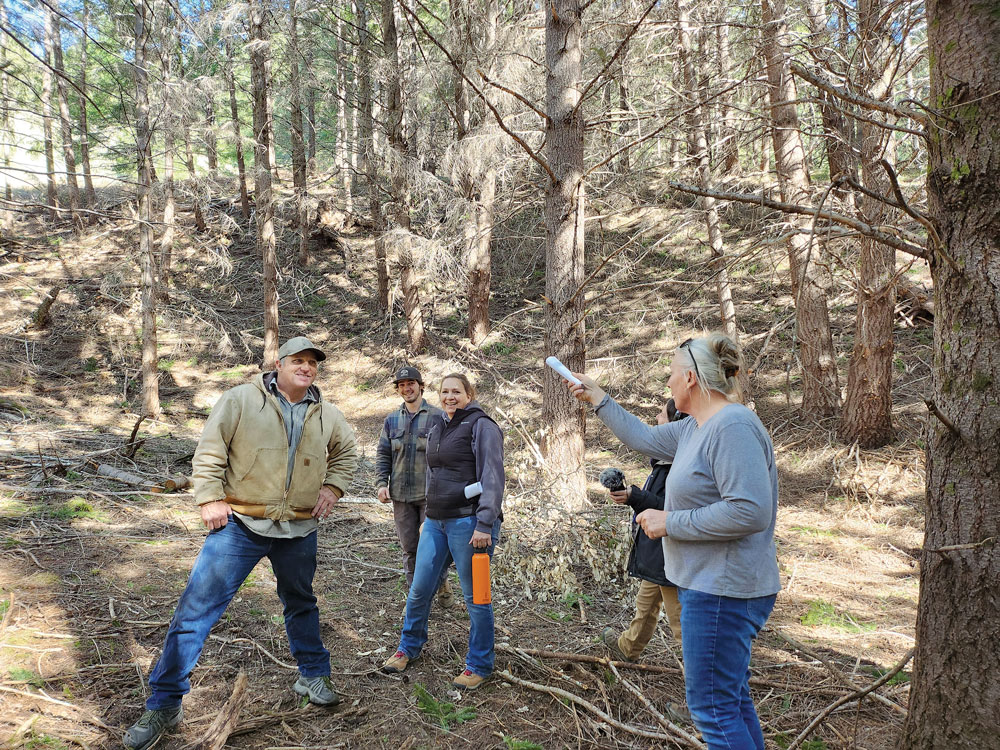
Photo by Karen Youngblood
Local and Regional Bright Spots
There are multiple active projects and proposals that especially address fire and forest stewardship. Fire departments and companies, fire-safe councils, tribes, for-profit and non-profit organizations, and layers of government from municipal to county to state to national are all engaged. A recent proposal was submitted for Traditional Ecological Knowledge (TEK) fire on Duggans Opening and Chinquapin Springs Tan Oak Grove in ridges between the South Fork Eel and Usal watersheds. The proposal is co-sponsored by Eel River Wailaki, Native Health in Native Hands, Southern Humboldt Prescribed Burn Association, and Redwood Forest Foundation, Inc. (RFFI)/Usal Redwood Forest.
Good fire burns are being planned for many locations, including Southern Humboldt Community Park and Mail Ridge, Salmon Creek, and Telegraph Ridge recently received key funding. There is too much happening on this front for me to fully describe.
The North Coast Resource Partnership is a long term, collaboration among Northern California Tribes, counties, and diverse stakeholders. To view many of their innovative past, present, and future projects visit: NorthcoastResourcePartnershipProjects.org.
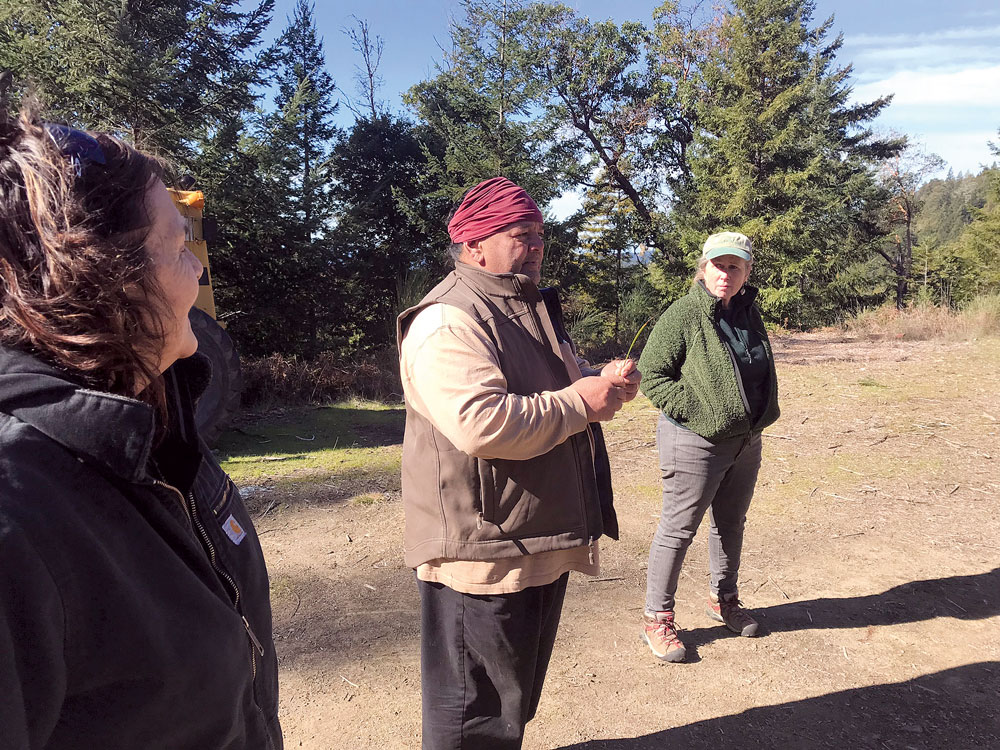
Another Quick Positive Note
The 24th Annual Coho Confab in September 2022 went splendidly. I was especially moved by the tour of Anderson Creek’s Coho refugia, with more than 20 other participants. This creek—a lot of it within RFFI’s Usal Redwood Forest as well as Sinkyone State Wilderness and the InterTribal Sinkyone Wilderness—had more than a dozen spawning Coho in late December 2022, according to reports. [See page 17 for information on this year’s Coho Confab.]
Stretching Out to Give You Six Suggested Readings
The six include three 2022 books written by deep researcher of Humboldt County, Jerry Rohde. All three are available at Blue Moon Gift Shop in Garberville, CA and other outlets in Northern Humboldt and nationally.
1) Southern Humboldt Indians
2) Southwest Humboldt Hinterlands
3) Southeast Humboldt Hinterlands
My #4 suggestion offers lots of California and regional history in a book by Tom Harris about an incredible person and his career, including an Epilogue written by the man himself, Richard Wilson. One of my favorite parts is Chapter 5 about the Mendocino County Forest Practice Rules saga—foundational, folks, foundational.
4) Stand for the Land—A Defining Duty of Richard A. Wilson
Not to get you too depressed, or riled up, but my fifth suggestion tunes you up for understanding a lot that is going on today. The exhaustively researched book by Gerald Horne gives facts on these dark (and recurring?) chapters of history.
5) The Counter-Revolution of 1836: Texas Slavery & Jim Crow and the Roots of U.S. Fascism
And #6, a new improved and expanded 3rd edition of John Perlin’s classic book:
6) A Forest Journey—The Role of Trees in the Fate of Civilization
Please help out where and when you can on all the issues before us. Check out the work of Sanctuary Forest, the Institute for Sustainable Forestry, EPIC, Forests Forever, Redwood Forest Foundation, Inc., and Save California Salmon.
To Get Involved
•Richard Gienger, [email protected], 707/223-6474
•EPIC, wildcalifornia.org
• Forests Forever, www.forestsforever.org
• Mendocino Trails Stewards, mendocinotrailstewards.org
• Pomo Land Back, www.pomolandback.com
• Redwood Forest Foundation, Inc., www.rffi.org
• Sanctuary Forest, sanctuaryforest.org
• Save California Salmon, www.californiasalmon.org
• Save Jackson Coalition, savejackson.org
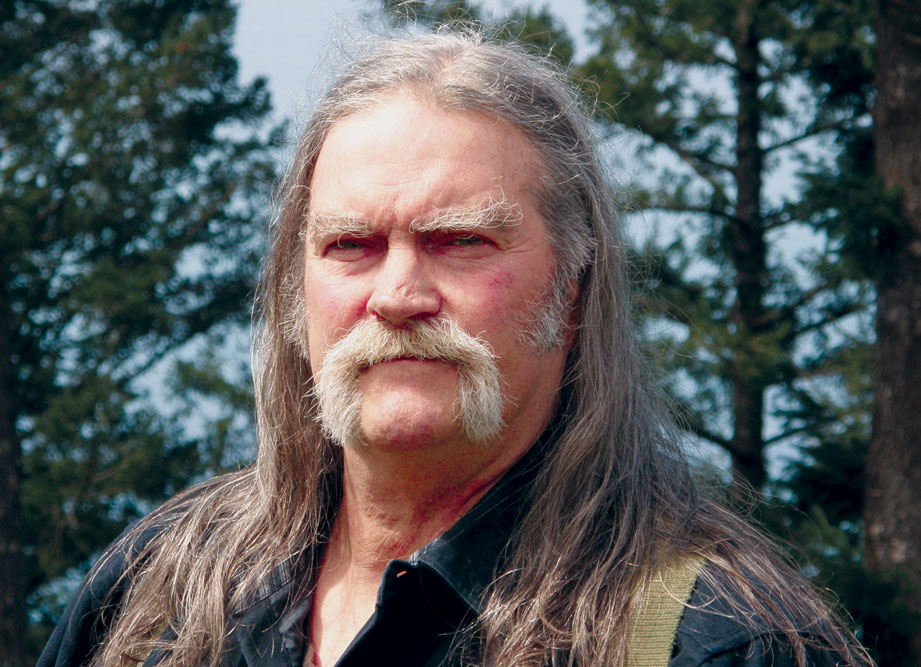
Since arriving in the Mattole Valley of Humboldt County in 1971, Richard Gienger has immersed himself in homesteading, forest activism, and watershed restoration. Richard’s column covers a range of issues including fisheries, watershed restoration, and forestry, plus describes opportunities for the public to make positive contributions in the administrative and legislative arenas as well as in their own backyards.
